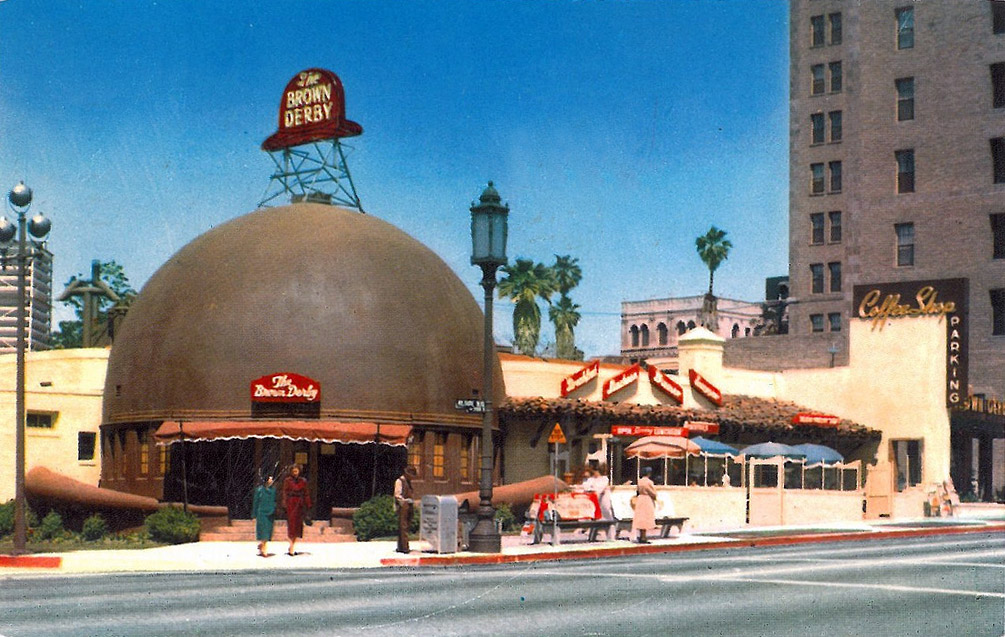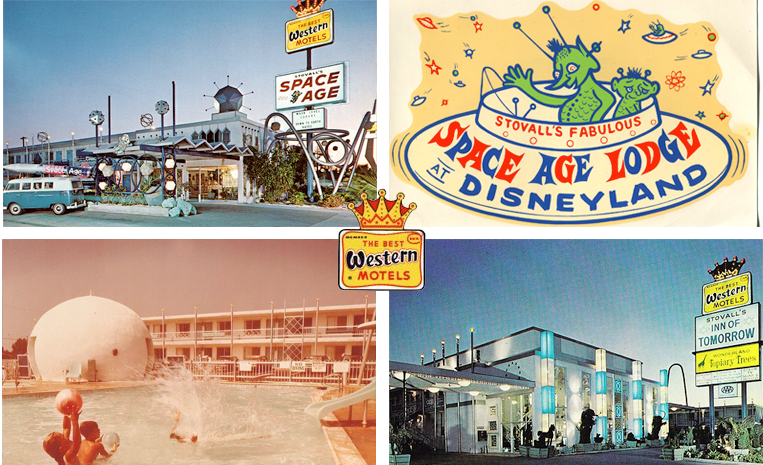
If you want to check in to yesterday’s wondrous tomorrow, all you have to do is make a reservation today at the Howard Johnson Anaheim Hotel to book a stay in the past’s future. Confusing? No, it’s not an episode of Rod Serling’s The Twilight Zone or a treatment for a new Back to the Future film. It’s a look at the delightfully “far-out” space-age design heritage of today’s Howard Johnson Anaheim Hotel and the “Googie” ghosts of Anaheim’s past.
In his 2012 story for Smithsonian Magazine (“Googie: Architecture of the Space Age”), writer Matt Novak states:
Googie is a modern (ultramodern, even) architectural style that helps us understand post-WWII American futurism — an era thought of as a “golden age” of futurist design for many here in the year 2012. It’s a style built on exaggeration; on dramatic angles; on plastic and steel and neon and wide-eyed technological optimism. It draws inspiration from Space Age ideals and rocketship dreams. We find Googie at the 1964 New York World’s Fair, the Space Needle in Seattle, the mid-century design of Disneyland’s Tomorrowland, in Arthur Radebaugh‘s postwar illustrations, and countless coffee shops and motels across the U.S.
The editors of Wikipedia define Googie as “a type of futurist architecture influenced by car culture, jets, the Atomic Age, and the Space Age. It originated in Southern California from the Streamline Moderne architecture of the 1930s and was popular in the United States from roughly 1945 to the early 1970s.” Is it any wonder this design movement was borne from the same environment that gave us Hollywood, Disneyland, and countless themed restaurants such as Cliftons, The Brown Derby, Tail of the Pup, and the Tam O’Shanter?

The era of “Googie” and its design influence was abundantly evident throughout the 1960s in what is now known as the Anaheim Resort District. Futuristic hospitality could be found at such locales as The Galaxy Motel, Stovall’s Space Age Lodge, Inn of Tomorrow, Cosmic Age Lodge, and the Apollo Inn, all of which once dotted Harbor Boulevard, the main thoroughfare where the Disneyland Park Main Entrance was once located. Today, only two genuinely authentic examples of the areas Googie past live on, the original Anaheim Convention Center arena and, you guessed it, Howard Johnson Motor Lodge (aka Howard Johnson Anaheim Hotel).


In 1965, when the gleaming white and orange edifice of the Howard Johnson Motor Lodge (now known as the Howard Johnson Anaheim Hotel and Water Park) rose out of the orange and walnut groves of somewhat still rural Anaheim, California, it must have looked like an alien civilization emerging from the earth’s crust. However, it did sort of fit into the neighborhood, for across the street beckoned the futuristic skyline of Disneyland’s Tomorrowland, faintly visible beyond the park’s densely forested
15-foot-high berm.

With its iconic undulating arched architecture, white stucco exterior, bright orange rooftop, and “mod”-inspired interior lobby (complete with cool wavey-orb lighting fixtures hanging from the ceiling and a starburst Modernist wall clock), Howard Johnson Anaheim Hotel seems like a distant cousin to the TWA Hotel at New York’s JFK Airport. It’s a west coast setting straight out of the hit TV series Mad Men (except, being a family-oriented hotel, there are no readily available cocktails, cigarettes, or other 1960s
vices).

What is available at the Howard Johnson Anaheim Hotel is an abundance of space-age charm, almost perpetual sunshine, and lovely tropical landscaping encouraging the hotel’s relaxed vibe. The interior settings are complete with vintage-era posters from its world-famous neighbor, artwork by famed mid-century modern inspired artist SHAG, plus the hotel’s one-of-a-kind “House of the Retro Future Suite,” an homage to Anaheim’s Googie past and the Monsanto House of the Future that was once featured at
Disneyland.
Seemingly to cap off Anaheim’s Googie heyday came the 1967 debut of the Anaheim Convention Center Arena. Looking as if it had just landed from some far-off galaxy, the hall was the last structure built in the resort district that epitomized the Googie design movement in the city. Its domelike form is more than a little evocative of the LAX Theme Building.

Exemplifying the arena’s latent Googie credentials, the once state-of-the-art venue once hosted the likes of such musical legends as Elvis Presley, Simon & Garfunkel, Ray Charles, Credence Clearwater Revival, and The Doors. Now, nearly six decades later, the arena still stands iconic and emblematic of an
era of design that has proven timeless, bold, and forever of the future.

